Warner Bros. Pictures (November 14 2003), Warner Home Video (March 2 2004), single disc, 92 mins plus supplements, 2.40:1 anamorphic widescreen, Dolby Digital 5.1 Surround, Rated PG, Retail: $19.99
Storyboard:
Opening at the famed Warner Brothers Studio, we find Daffy Duck pushing himself for a major role in Bugs Bunny’s latest movie (ironically enough, Back In Action does end up being very much Daffy’s film). Finally fed up with Daffy’s self-promotion, the Brothers Warner fire the duck – something security guard DJ Drake (Brendan Fraser) has trouble doing, leading to them both being kicked off the lot. Soon realising that the Bunny needs a sidekick, Bugs and comedy executive Kate (Jenna Elfman) hit the road in search of Daffy, who unbeknownst to them is already off on his next adventure with DJ – the quest to find the legendary Blue Monkey diamond, a supernatural rock that reverts humans back to their primate state! So it’s off to destination Las Vegas, where they meet Heather Locklear as a modern day, real life Jessica Rabbit figure, followed by the evil new head of the ACME Corporation (Steve Martin, sporting a Henry Selick look), who has captured DJ’s father, movie spy hero Damian Drake (a nice comic turn by ex-Bond Timothy Dalton) – also on the trail of the Blue Monkey. The ACME plan is to turn humans into monkeys and get them to make products on the cheap before changing them back into humans ripe to make a purchase – which could mean the end of civilization as we know it!
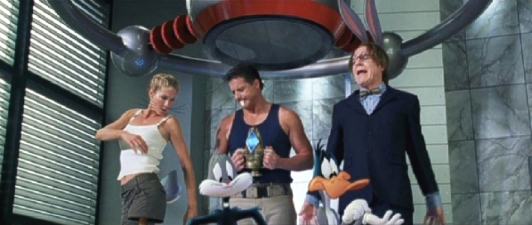
The Sweatbox Review:
I’ve been waiting to see a Joe Dante-helmed Looney Tunes movie for the best part of 15 years – ever since Who Framed Roger Rabbit became such a domestic and international success in 1988, in fact. When that film hit screens, it prompted the first wave of Studios to try and jump on the animation bandwagon (something that failed to happen until The Lion King, over five years later, really brought home the animated bacon). As Roger and co lit up the theaters, and Disney/Amblin’s coffers, Warner Brothers announced a never-to-happen Bugs Bunny-Chevy Chase road comedy, while Terry Gilliam (who had himself turned down Roger Rabbit, due to it sounding like “too much work”!) was finally given the go-ahead to make his as-yet unmade The Defective Detective, Paramount jumped in with the rushed and troubled Cool World, and there was, of course, much talk of a fully-fledged sequel (or prequel – or both, depending on your source) to Roger Rabbit.
Of course, none of these projects fell into place (including, arguably, the mess that was Cool World) and the closest we got to a return trip to ToonTown was with the three Roger Rabbit-Maroon Cartoons made by Disney and Amblin. Eventually, the 1996 feature from Warners, Space Jam attempted to mine the same field, but way back around the time that Roger originally hit so big, another feature was mooted, and looked to go into production for a while: this was Joe Dante’s Termite Terrace, an animated/live-action combo film, like Roger, which would pay homage to the classic 1930s and 40s stable of WB characters and see them at work, making their most famous cartoons. Unfortunately, the brass at Warners at the time thought the project to be a little TOO much like Roger, playing as one massive in-joke that only Dante, and the animation fans like him, would understand and be able to laugh at.
Despite a great sounding premise (again, I say that as a huge animation fan), the film was placed on the back burner, and the Studio went ahead with the well intentioned, but ultimately hollow Space Jam (though it shows how powerful the legacy of Roger is in that it seems any modern Looney Tunes movie has to be an animated/live-action blend). And why wasn’t Dante carried over to that project? Well, after years of begging for a sequel to Warners’ biggest hit, Gremlins (1984), Dante finally delivered Gremlins 2: The New Batch, a film aimed at movie-geeks and filled with so many in-jokes and references that it killed off the franchise stone dead – if this was the kind of Looney Tunes movie Dante wanted to deliver, then WB would darn well make one without him!
Flash forward ten years or so, and the general feeling at the WB was that, while Space Jam had made tons of money in film sales and merchandising, and brought back the Looney Tunes characters into the public eye, they had become homogenised, watered down versions of their old Avery-Clampett-Jones heyday selves. Realising the obligation they owed to their most popular characters, another Looney movie was on the cards, and this time the WB execs knew they had to go in another direction to where Space Jam had stepped, and wanted to bring the characters literally back down to earth and back to their basics: step forward…Joe Dante!

I’ve been a fan of Dante’s since his rough-and-ready style at Roger Corman’s, through his rip-off movies Piranha and The Howling, and most certainly through his Spielberg-phase, which consisted of the Gremlins movies, and the underrated but excellent sci-fi comedy InnerSpace (1987). At that point, he was well in there with the likes of Robert Zemeckis and co, and one wonders if Bob Z had turned down Roger Rabbit again (it took several goes to get him to sign) if Joe wouldn’t have picked up the slack? Since then, he’s wandered off in several directions, most notably with Tom Hanks in the hysterical The ’Burbs, and the cute but bland Matinee – all films filled with in-jokes and movie fan references – and then back to Spielberg again for the live-action/CG Small Soldiers. These are the kinds of films he makes: a film fan making movies for film fans. And through them all has been this anarchic sense of the absurd, something that mainly seems to spring from his love of the classic WB cartoons (witness his segment of Twilight Zone: The Movie, which is set in an animated world, or the re-shot end of Explorers, where River Phoenix and his friends end up in a space-ship with a cartoon-crazed alien). Even Gremlins has a fair share of Looney Tune-inspired madness, Gremlins 2 even more so, with that Bugs ‘n’ Daffy opening, and InnerSpace trumps them all by having a cameo from Mr Looney Tunes himself, director Chuck Jones!
So, with early publicity announcing that Dante was approaching the new Looney Tunes movie as “the anti-Space Jam movie”, things looked good. The script sounded fun, the cast was shaping up with a few big names (Steve Martin and Brendan Fraser, himself no stranger to fantastical animated goings on after appearing in The Mummy films and the uproarious MonkeyBone), and then none other than Eric (Aladdin’s big blue Genie) Goldberg came on board as director of animation. On set photos revealed the movie was being shot in the CinemaScope-styled widescreen process – this really was going to be the Looney Tunes movie to end all Looney Tunes movies! And then, actually, it nearly was…
Following a disastrous showing at the US box office last November (and not doing that much better worldwide), it’s time to give Looney Tunes: Back In Action another chance on DVD. Now, with the movie just coming out in the UK cinemas, I opted to wait for the disc to show up, cracked it open with a couple of friends, all of which had heard similar bad things about it, and settled down to take it all in. First impressions? Not as good as the almost un-touchable Who Framed Roger Rabbit, perhaps naturally, but nowhere near as lame and blasé as the previous Space Jam outing, either. In fact, there’s much to like about LT: BIA, and not least the slightly “adult” nature of the script – we’re back to having the Looney gang the way we love ’em, folks!
The animation and effects meld reasonably well – much better than in Ralph Bakshi’s totally redundant Cool World, and somewhat better than Space Jam. There seems to be a much better understanding of what makes these characters who they are from the filmmakers, leading to better animation movement and timing. Technology has come on leaps and bounds, so the interaction between the ’toons and the human cast is almost a given, something that never really gelled for me in Space Jam, and that only seems to work sporadically here. Maybe it’s a computer thing, since apart from a couple of viewpoints going askew in Roger Rabbit, Bob Hoskins and the crew had it pretty nailed down, although having said that, I was impressed by the level of “realism” that The Adventures Of Rocky And Bullwinkle movie achieved, even if the leads were computer generated. Likewise, in MonkeyBone, Fraser proved that he’s adept at “acting to nothing”, though here he seems to realize that he’s in a “human cartoon” – something in Dante’s direction perhaps?
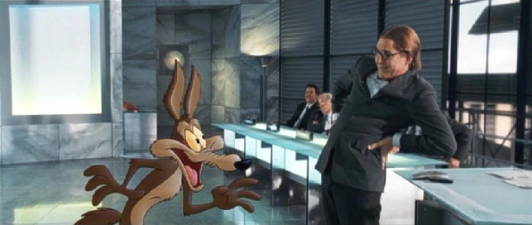
This was something I also noticed in Space Jam, where the characters were also digitally inserted into the live-action plates. With Roger Rabbit, the elements were reproduced “the old fashioned way”, through an optical printer, providing a greater sense of fusing the two worlds together. In that film, the characters really are almost there, whereas in these two Looney Tunes movies, there is a slight element of separation, where the characters look one layer “up” and superimposed as opposed to fitting right in. It’s an interesting debate, especially when one factors in that director of photography Dean Cundey shot both Roger Rabbit and now Back In Action. However, this nit-picking aside (which will go un-noticed by the majority of fans), the audience is given a high level of animation and live-action interaction, and it is all handled with great care and attention, as one would expect from such an experienced cinematographer as Cundey (who also gets to play with a flying car again, after perfecting the illusion in Back To The Future Part II). The interaction works well overall, though it’s a little off in the shots where the human cast have to “handle” the animated characters, and the perspective on some of the running and dodging shots doesn’t come off quite as successful as they might have.
On the sound side, long-time Dante composer Jerry Goldsmith provides the Tunes this go around, and for him Back In Action is a major departure. Goldsmith’s music is usually highlighted by sweeping, majestic strings and big, bombastic, stabbing brass, though it is always grounded in some sort of reality (or at least as real as the movies he scores get). Even his previous forays into the animated world, most notably with Disney’s Mulan and Bluth’s The Secret Of NIMH, are scored with a live-action approach in mind, helping the music play along and support the events on screen, rather than “Mickey Mousing” the action. But with BIA, he goes flat out Looney Tunes, hitting every beat, and thrashing every note on every action, in typical Carl Stalling-Warners-hallmark style. To be honest, I’m not sure that it works, eventually leading me to think that the meld between styles, especially a Danny Elfman-Men In Black-styled espionage theme based on an instantly recognizable Stalling theme, didn’t quite fit in with the action on screen, and certainly the use of modern rock tracks stood out as moments where the soundtrack failed to gel.
Unbelievably, I also felt that Dante’s direction could also do with a little pepping up: much of the action, particularly when the animated characters were carrying a scene, felt slow and labored – not at all like the majority of his stuff, especially his last two Warners films, InnerSpace and Gremlins 2. The much-discussed Louvre sequence is certainly a high point, though again, I was expecting the kind of zippy, Tex Avery-esque action, with a great many more different styles and paintings to be spoofed. It’s expertly done, of course (there’s even a fun swipe at Disney’s recent Destino short), and just shows how computer technology can help advance simple ideas and elevate them to new levels. However, the start-stop nature of this section (we suddenly cut to find what our live-action leads are up to) did lift me out of the film for a moment (and no matter how great movie tricks get, they still can’t seem to create lifelike blue screen photography that doesn’t look hokey).
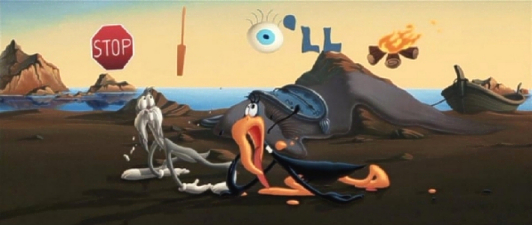
Speaking of the leads, the cast do fine with what they’ve been given to work with; Steve Martin especially comes out of the whole thing with a new level of insane “wild and crazy guy” playing that will please his many fans and amuse the kids on the whole. With his Harold Lloyd-styled horn rimmed glasses and page boy, center-parted haircut, I’m sure he’s meant to be a send up of stop-motion director Henry Selick, who himself directed Brendan Fraser in MonkeyBone. Fraser and Jenna Elfman are also good value, both dipping to new depths and playing up their roles to the hilt. They’re not as spot on as Bob Hoskins was in Roger Rabbit at looking at the later-to-be-animated characters, but at least there’s a lot more happening overall than in Space Jam, which took an age to get motoring.
Likewise, the voice cast (counting among them a certain Brendan Fraser as the Tasmanian Devil, and animation director Goldberg as Marvin The Martian following in the footsteps of Roger Rabbit’s Richard Williams providing Droopy’s vocals) is great. Joe Alasky and Jeff Glenn Bennet fill in for the much missed Mel Blanc, and their impersonations feel just right, or at least as close to the originals as the Looney Tunes have been heard in recent times, with June Foray herself returning to her signature role of Granny. There are also the usual Joe Dante suspects: “good luck charms” Robert Picardo, Dick Miller, Archie Hahn and Kevin McCarthy (in one of the film’s many laugh out loud moments) make their customary appearances, and Dante packs each scene with amusing cameos and characters from both his previous films and many of his favorites, particularly the sci-fi epics of the 50s and 60s (this was the first time in decades that I caught a Doctor Who Dalek on the big screen)! The widescreen framing and typical piled-on nature of the Looney Tunes allows many of these gags to surface, and there are way too many to start pointing out here – that’s part of the fun of watching the movie – though listen out for character names (“Hey Bob, Chuck, Mel!”), keep an eye on backgrounds for the tiniest details, and look out for Scooby-Doo and Shaggy’s rather “flat” appearance in the Studio cafeteria – very clever stuff!
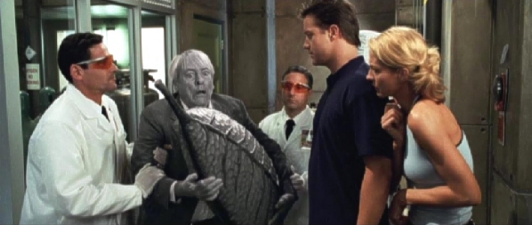
Dante tried to be careful not to get stuck in the Space Jam rut, where the film was essentially made by committee as a feature-length commercial but, clearly on board as director-for-hire, found himself up against several brick walls throughout production. These don’t manifest themselves on-screen as anything to draw attention to themselves, though one can bet that any intrusions that did come along were buried good and proper among all the other mayhem going on in the film. Dante does get his own back, though, with several digs at corporate politics – the WB included – though it’s open to debate whether the highlighted Wal-Mart gag really is product placement or simply just a very funny moment. It wouldn’t be right to say that everything comes together to provide a harmonious Tune, being that the visuals, music, sound effects, voices and acting styles all simply crash jointly at the same time, making up a kaleidoscope effect of a movie that will divide audiences one way or the other.
Personally, I love these kinds of films, where anything goes, no joke is worth sparing, and any and all set pieces are thrown together, in a futile, but nonetheless entertaining attempt at creating something coherent. Not that the film has much of a plot, it being more of your basic core storyline – let’s get from A to B and have fun along the way – but to place anymore plot within the frame of the movie would, as with the likes of Moulin Rouge, break its backbone. However, with LT: BIA, it seems there was an over-emphasis on going overboard with the onslaught of humor, sound and imagery, and the film itself could quite easily leave a viewer exhausted!
On speaking about the Spielberg/Zemeckis movie 1941, critic Pauline Kael wrote that it was “like spending two hours with your head stuck in a pinball machine” – a quote that Zemeckis later used to describe his own Who Framed Roger Rabbit. With a loud, splashy mix of comedy, music, and animation in abundance in Looney Tunes: Back In Action, I guess you could equally say the same thing about Dante’s film; it certainly lives up to its heritage: that of the throwaway, classic Looney Tunes attitude of pure abandon that’s been missing in big features of late. Without the elements all gelling together a little more consistently, I can see why this failed to win over big audiences, and you’ll find that you either love it or hate it. However, there’s no denying that it’s certainly an exuberant 90-minute ride, and despite some minor technical misgivings, let’s hope that Bugs and co will shine on the big screen again soon!
Is This Thing Loaded?
“What’s up, doc?” Where is the audio commentary? The extensive “making of”? A second disc? Ahh well, perhaps befitting its lacklustre performance in the theaters last November, Warners have elected to only provide a limited number of extras on LT: BIA’s DVD incarnation, much like the selection found on other WB titles like The Quest For Camelot, The Iron Giant and Osmosis Jones.

First up is a fast and snappy promo for the Looney Tunes Golden Collection (“featuring all your favorite characters – many of them not wearing pants!”), lasting just over a minute and which keeps in mind the film’s classic audience. This is followed by the fun main menu, featuring recycled animation from the film with new disc-specific voiceovers that play up the animosity between Bugs and Daffy. The usual options can be accessed from here, including languages, scene selections and the special features.
The first bonus I jumped to was the new 7-minute Looney Tunes cartoon, The Whizzard Of Ow, which debuted not with the theatrical feature, but in Wal-Mart stores across America! Strangely, the short seems to have been shot for 1.85:1 (as evidenced by the letterboxed opening), but this edition annoyingly crops the sides and presents a 1.33:1 fullscreen image. After a brief credits sequence, the action opens up on two masters of sorcery practising their craft against one another until they blow themselves away, with one of their books containing the secret of their magic landing on Wile E Coyote’s head. Poor old Coyote’s in the midst of chasing his old nemesis the Road Runner, but finds the book helpful in harnessing the power of magic to catch the speedy bird, leading to the usual antics we’ve come to expect from the series.
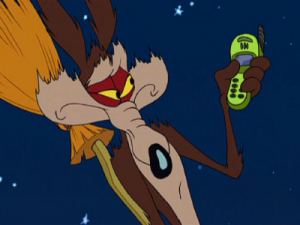
Apart from the odd new Looney Tunes opening graphics (not quite the way we all remember, folks!), the cartoon is pretty standard going, with some genuinely funny new gags, characteristic timing, and animation that looks right out of the golden Looney Tunes period (it’s certainly better than the kind employed on the various WB television shows, and gives the 1990s shorts a run for their money). In fact, apart from the absolutely pristine transfer, this could run in a block of classic Road Runner/Coyote cartoons and one wouldn’t be able to tell the difference. John Frizzell’s score matches the Stalling approach that seems AWOL in the 1970s revivals and the BIA main feature (even employing that old staple, Wagner’s Ride Of The Valkyries). The tighter framing, once the characters come into play, doesn’t detract from the enjoyment of the short, though quite why Warners didn’t supply a widescreen version for the widescreen disc, when they usually go all out to provide such things in their original format, is a mystery.

Behind The Tunes sees Bugs and Daffy, through recycled animation again, take us on a tour of the set. The almost 9-minute featurette doesn’t use the opening branding that the Golden Collection uses on the similarly named featurettes, though the participants, including director Dante, Fraser and Elfman, all get named checked with the same “signpost” tags. We also get a look at the set design, props, vehicles and the animation process, though the voiceover artists don’t get a look in this time around. The actual making of the film takes a back seat, however, to accommodate a set up that sees Daffy trying to take control of the movie, coming off worse than anyone, as usual!
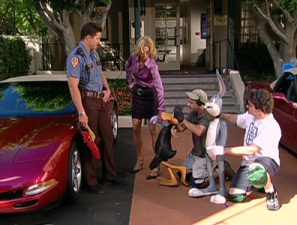
Bang, Crash, Boom! still doesn’t highlight any of the voice talent, but takes a closer look at filming and inserting the animated characters, miniature effects, animatics and interaction special effects of Back In Action (7:20 mins). By now, I was beginning to find Bugs and Daffy’s incessant narration somewhat annoying, but at least this featurette focuses more on the making of the film and several of its visual effects shots. Both of these behind-the-scenes peeks are presented in 4:3 full-frame, with letterboxed film clips.
Looney Tunes: Out Of Action presents the “best scenes you’ve never seen” – or more simply, 10-and-a-half minutes of deleted scenes (presented again in letterboxed full-frame). Once again, these are presented by the Bunny and the Duck, and run more as a series of clips than full deleted scenes. Bugs and Daffy do feel the need to point out everything, even when the scene is fairly long (such as the alternate openings and the ending, which I’ll especially bet Jenna Elfman was more than happy they cut)! The original opening to the film looks mighty good fun, much like the original opening to Toy Story that had Buzz Lightyear in full battle mode against Zurg. Here we get Daffy, all spruced up superhero style, saving the day from Elmer Fudd and his gargantuan robot fiend, in a sequence presented mostly in pencil animation, with some CGI basic passes thrown in.
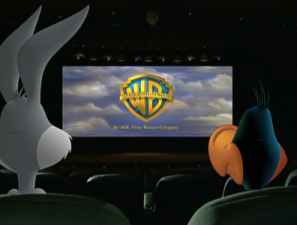
It’s clear why the sequence was cut for a number of reasons: one perhaps because it would detract from the later scene in the film where Daffy assumes his Duck Dodgers persona, another maybe since they had the Dodgers character, why introduce a new variant? The main reason, I think, is that it doesn’t present the Looney Tunes in the way we’re most familiar with seeing them, something the film on the whole strives to do, and by changing this beginning for the one in the film at least starts us off on familiar footing. However I will say that in the eventually used beginning, the main title isn’t given the treatment it deserves – and gets here.
Finally, the film’s Theatrical Trailer is included in pristine anamorphic widescreen. Note that this isn’t actually the second, full trailer for BIA, but the original teaser that presents the first three letters of the Looney Tunes logo as a sideswipe at the James Bond 007 franchise. There’s some new animation created for this one, and it’s nice to have it on the disc, though it’s a shame that the (admittedly similar) second trailer couldn’t be squeezed on as well, with that great opening Coyote/phone gag. A good teaser though, running about standard length for a first look, clocking in at around one-and-a-half minutes. One last, but pointless, little Easter Egg can be found by nudging over to the WB water tower.

And “that’s all, folks!” It would have been nice to have heard from director Dante and his animation supremo Eric Goldberg, though this kind of feature could turn up in an inevitable later 2-disc re-issue (in a Space Jam double pack, perhaps?), or it could be that, given the interfering nature of production, that poor old Joe just wants to put the whole thing behind him and move on? The absolute icing on the cake would also have been the inclusion of the original Rabbit Fire short that “opens” the movie, or even perhaps the entire, unofficial “Hunting Trilogy” of similar cartoons. Warners missed a chance at cross-company synergy there: why not include the cartoon, an undisputed classic, and point up the fact that it came from the (“now available!”) Looney Tunes Golden Collection, or at least given us a sneak peek at what to expect on the next compilation? Keep the fans loyal, guys!
On Warners side, though, it’s great to report that this time there really is something worthwhile encoded as additional DVD-ROM material. On the minus side, however, it’s much like Universal’s “Total Axess” feature, and while you won’t need to hook up to an internet connection to enjoy the 26-or-so minutes of bonus footage on offer here, the bad news is that it all sounds like good stuff that many will complain should have been on the main video section of the disc. I say “sounds”, since as usual the InterActual player bundled on the disc didn’t want to play for me, repeatedly announcing that it was “unable to load the default skin”, and despite my many attempts to reinstall, it still locked me out, thus knocking a couple of notches off my overall supplemental features score.
Case Study:
A usual snapper case from Warners, but one thing I noticed were the words “The Movie!” plastered under the main title, on the front and sides of the box, and on the disc artwork, in true “blurb” style. What else might you expect Back In Action to be? More worryingly, there’s also a rebate offer that guarantees $5 back when you purchase the truly awful Reality Check and Stranger Than Fiction discs made up of the tiresome recent web series. Really, for five bucks – it’s really not worth it for these poorly Flash animated abominations (but at least it probably means that sales of those two titles are “below expectations”, which can be no bad thing)!
Ink And Paint:

Available in both widescreen and cropped full-screen editions, we’re naturally taking a look at the widescreen version here, which preserves the full theatrical exhibition framing of 2.40:1. Dante’s only been using the wider frame more recently, usually sticking to a 1.85:1 ratio, but he and Cundey pack it in here as much as can be, fully using all areas of the screen. In fact, some of the shots look a little too packed, and on comparing some to the trailer, it’s clear that this was shot to a “taller” frame (most likely 1.66:1) and matted in the theater. The monitors show the full 2.40 frame in the supplemental behind-the-scenes footage, so it was framed that way on set, but I did get a feeling that the film might have benefited from being opened up a little to 1.85:1 for home video – it’s definitely cramped in some sections. The transfer though, as one would expect for a film less than four months old, is bang up to date and state of the art, and looks to be digital-to-digital. An astonishingly vibrant image, with the bright colors held in check…this is as good as demo material.
Scratch Tracks:
Punching through with a strong Dolby Digital 5.1 surround track, Back In Action also provides the audio goods. Dialogue never sounds too replaced (a frequent characteristic of animated/live-action films) and the cartoon characters voices blend well with the human cast. Music blasts from the stereo pair and the rear is the most active I’ve heard on a recent film, lending to that “pinball machine” feeling again. The one thing I felt lacking was the bass, especially on directional effects, thuds and explosions, which sounded a little flat. But as with the visuals, this is a packed soundtrack, and given enough volume will test your system out fully! French and Spanish dubs are provided in full 5.1, with subtitles in those languages also available.
Final Cut:
While not the Looney Tunes movie to end all Looney Tunes movies, this DVD follows suit, providing decent, if not exemplary extras, and a high-quality version of the main feature. What Dante set out to do was to produce a Looney movie that would appeal to kids, but would more importantly appeal to the adults who loved Bugs and co as kids. Where he and the Studio failed was in the constant switching between audiences and tone, with the film never settling for one or the other. However, animation and general film fans, as well as anyone who ever watched a Bugs Bunny cartoon, will have a blast. I’m not sure it warrants my 15 year wait, and it has some pretty big, Roger Rabbit-sized shoes to fill, but Back In Action proves that there’s plenty more life in them thar characters still, and hopefully the box-office numbers won’t mean that it’s “That’s all, folks!” for a long, long time yet!
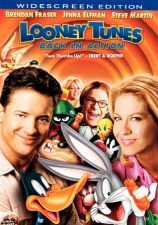 | ||
 |







